
Asteridea is a genus of flowering plants in the family Asteraceae. Evidence suggests that the genus, Asteridea, is monophyletic.

Grevillea stenobotrya is a shrub or small tree in the family Proteaceae that is endemic to arid regions of Australia. Common names include rattle-pod grevillea, sandhill grevillea, sandhill oak and sandhill spider flower.

Nymphoides crenata, commonly known as wavy marshwort, is an aquatic perennial herb of the family Menyanthaceae endemic to Australia, found in all mainland states and the Northern Territory

Cyanothamnus bussellianus is a plant in the citrus family, Rutaceae and is endemic to the south-west of Western Australia. It is a slender perennial herb or shrub with well-spaced, simple leaves and pink, blue or white, four-petalled flowers.
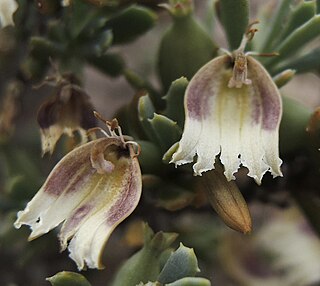
Scaevola collaris is a shrub in the family Goodeniaceae and its native range is five mainland states/territories of Australia: the Northern Territory, New South Wales, South Australia, Queensland and Western Australia.

Xanthosia atkinsoniana, is a small herb in the family Apiaceae. It grows in both New South Wales and Western Australia.

Dampiera candicans is a plant in the family Goodeniaceae, native to Western Australia and the Northern Territory.

Ptilotus schwartzii is a grass-like plant in the Amaranthaceae family.

Asteridea pulverulenta is a species of flowering plant in the Asteraceae family, which is endemic to Western Australia, in the south-west. It was first described in 1839 by John Lindley.
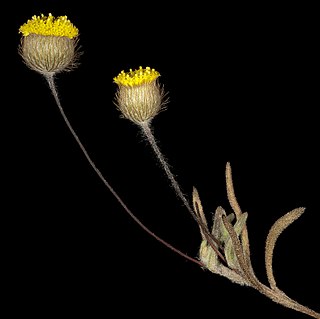
Asteridea athrixioides is a herb in the Asteraceae family, which is endemic to Australia, and found in Western Australia, South Australia and Victoria. It was first described in 1853 by Otto Sonder and Ferdinand von Mueller as Panaetia athrixioides, who described it from specimen(s) collected in the Port Lincoln district. In 1980, G. Kroner assigned it to the genus, Asteridea, giving it the name Asteridea athrixioides. It is an annual herb, growing on calcareous, sandy or clay soils to heights of from 5 cm to 20 cm. Its yellow flowers may seen from July to November on saline on allvial flats, rocky hills and undulating plains.
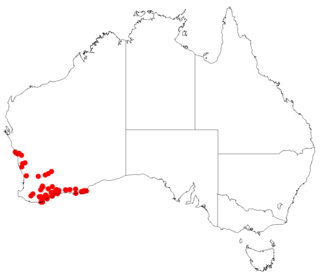
Asteridea asteroides is a herb in the Asteraceae family, which is endemic to Western Australia. It was first described in 1853 by Nikolai Turczaninow as Trichostegia asteroides. In 1980, G. Kroner assigned it to the genus, Asteridea, giving it the name Asteridea asteroides. It is a perennial herb, growing on sand or gravelly sand to heights of from 5 cm to 30 cm. Its white flowers may seen from August to November in Beard's South-West Province.
Asteridea archeri is a herb in the family Asteraceae, which is endemic to Western Australia. It was first described in 2000 by Philip Short. It is found growing on gypsum dunes in salt lakes to heights from 20 cm to 1 m. Its white flowers may seen from September to October in Beard's Eremaean Province. There are no synonyms.

Asteridea morawana is a herb in the Asteraceae family, which is endemic to Western Australia. It was first described in 2000 by Philip Short.
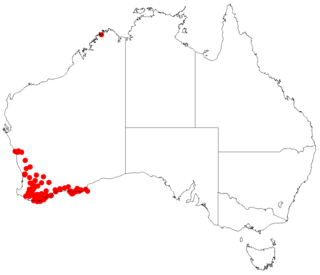
Asteridea nivea is a herb in the Asteraceae family, which is endemic to Western Australia. It was first described in 1845 by Joachim Steetz as Chrysodiscus niveus. In 1980, G. Kroner assigned it to the genus, Asteridea, giving it the name Asteridea nivea. It is a perennial herb, sometimes erect, sometimes low-spreading which grows on sandy soils often over granite, laterite, or limestone to heights from 10 cm to 60 cm, in rock crevices, on ridges and coastal cliffs. Its white to white-pink flowers may seen from April to May or August to September in Beard's South-West Province, that is, the IBRA regions of Avon Wheatbelt, Esperance Plains, Geraldton Sandplains, Jarrah Forest, Mallee, and Warren.
Asteridea croniniana is a herb in the Asteraceae family, which is endemic to Western Australia. It is an annual herb, growing to a height of 8 cm.

Westringia cephalantha is a shrub in the Lamiaceae family that is endemic to Western Australia.
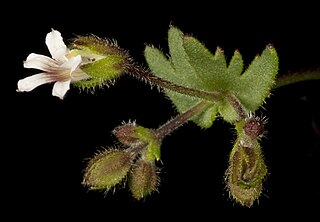
Goodenia cycnopotamica is a plant in the Goodeniaceae family which is endemic to Australia, and found in both South Australia and Western Australia

Ptilotus humilis is an annual herb in the Amaranthaceae family, native to Western Australia. It was first described as Trichinium humile by Nees von Esenbeck in 1845 but was transferred to the genus, Ptilotus, by Ferdinand von Mueller in 1868.

Macgregoria racemigera is a small plant in the family Celastraceae) found in inland Australia from New South Wales through Queensland, the Northern Territory to Western Australia, and South Australia.

Hybanthus floribundus is a plant in the Violaceae family, found in southern Western Australia, southern South Australia, Victoria and southern New South Wales.


















